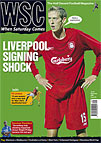 The Homeless World Cup, held this year in the streets of Edinburgh, plays a valuable social role for its participants, as Dianne Millen reports
The Homeless World Cup, held this year in the streets of Edinburgh, plays a valuable social role for its participants, as Dianne Millen reports
“Scotland To Face Italy in Semi-finals!” Not the most plausible of footballing headlines, you might think. But Scotland’s national team of homeless players did indeed reach the last four of the recent 3rd Homeless World Cup although they ultimately failed to overcome the eventual tournament winners.
Scotland’s success wasn’t the only unusual feature of this event. Street soccer is played in a small arena, each team has three outfield players plus keeper and each half lasts just seven minutes. The pace is fast and the play open, with the scorelines piling up like mismatched pre-season friendlies and 0-0 draws virtually unknown. It’s frantic, technically unsophisticated (although 16 players were signed up by clubs after the last one in Gothenburg) but fun to watch.
But the more fundamental differences between this World Cup and the “real thing” in Germany next summer are off the pitch. As aggressive global marketing tightens its grip on world football, increasingly it feels as if the games themselves are incidental to the opportunity for brands to be beamed into your living room. For the Homeless World Cup, however, sponsorship is still the means by which to ensure the event takes place, not vice versa. On one level, this is a practical necessity. Although the event is supported by UEFA, homeless teams do not have wealthy national associations behind them to fund their participation, and the players themselves lack resources. Indeed, five African teams were denied entry to the UK on the basis that they could not demonstrate they had sufficient funds for their stay (just after Edinburgh had called on the G8 summit to Make Poverty History). On a more political level, however, the organisation of the event also reflects the fact that street soccer is more than just a leisure pursuit but can be a route upwards and onwards for people whose lives have been affected by poverty, social exclusion and the many other misfortunes that can lead to homelessness. Indeed, the philosophy of the event is that if someone plays in more than one, it hasn’t really worked for them – the point is to change people’s lives and help them move on, and statistics from last year’s tournament indicate that it often does, with 74 per cent of participants having subsequently taken some sort of positive step such as finding employment.
But in practical terms, it’s not difficult to see why the corporate world might not want to associate its brands with the public’s generally negative stereotypes of the homeless, and this was reflected in the nature of the sponsors involved. Although Nike’s corporate social responsibility arm contributed, as did major local employer Standard Life, the main players were from the public sector – the local council, the Scottish Executive, and other social economy organisations. This gave the Cup a very different image from the set of powerful global consumer brands we’ll see displayed around the touchline in Germany 2006, but also, perhaps, encouraged the genuine sense of community involvement that permeated the event. Although street soccer is ultimately more fun to play than it is to watch – even with Scotland doing well, the games tended to blur into each other after a while – there was a fantastic atmosphere throughout, with the large crowd dispelling Edinburgh’s reputation for reticence and making some serious noise.
The almost tangible goodwill from the stands emerged from a sense that we were watching a genuinely significant experience for the players and coaches. Above all else, being part of the event was a major confidence booster for those involved. With so many homeless people worldwide accustomed to being treated with fear, contempt and even violence, the impact of being cheered by thousands of spectators, asked for autographs and generally treated like full members of the human race cannot be overestimated. As tournament director Mel Young explains: “Football connects people and is a grass roots sport for everyone. The Homeless World Cup is able to change the scenery and challenge stereotyping. People who have been spat at the week before are cheered by thousands and treated as soccer heroes during the tournament.” Sounds more worthwhile than pushing a few more zillion cans of carbonated beverages, doesn’t it?
From WSC 223 September 2005. What was happening this month